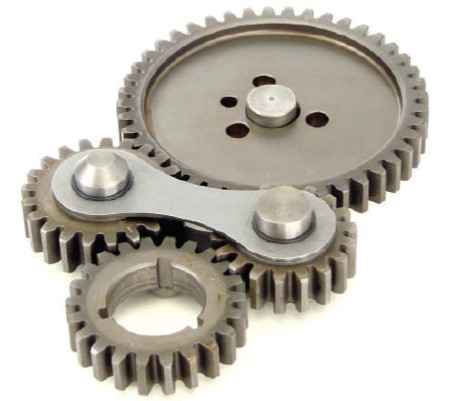Cam drive systems are responsible for controlling valve action relative to the crankshaft position. Three basic styles are available depending on the application, including chain, belt and gear. Here we’ll discuss the pros and cons of each.
Chain drive
Timing chain systems are perfectly functional for street and even some racing applications, and have successfully served as common choices for decades. Chain drives feature a toothed gear or “sprocket” secured to the camshaft and a gear/sprocket at the crank snout. Two basis styles include the link and roller types. Link style chains are the least expensive and are suitable for daily driver use on non-performance engines only. The links and their small bushings eventually wear and create sloppy cam timing and should not be considered. If you choose to use a chain drive, roller systems are the only way to go.
The rollers are more robust and provide more precise timing control. Both single roller and double roller setups are available, with crank and cam sprockets featuring single or double tooth rows. Either is acceptable, although double rollers offer more strength and more consistent timing. If a double roller setup is considered, be aware that a deeper aftermarket timing cover may be required for clearance.
With that said, be careful when choosing brands. Avoid bargain priced offshore systems that can feature marginal-strength materials and less-than precise machining. Stick with a quality setup such as those offered by established makers such as Cloyes, Melling, Comp, Elgin, etc. The quality of the materials and design are what counts. Roller chains may be made with seamed or seamless rollers, with seamless offering greater concentricity and greater durability. Cam sprockets may be made from cast iron, powdered metal or machined from billet steel. For the street, and for engines spitting out less than 300 HP, the higher cost of a billet gear simply isn’t necessary. Powdered metal is stronger than you might think, and is used in many OE higher-HP engines. But if you’re dealing with a more “extreme” application, paying a few extra bucks for a billet setup makes sense. If nothing else, it provides more peace of mind. The primary advice: buy the highest quality that you can afford. You really do get what you pay for.
The downside of a chain system is eventual wear in terms of chain “stretch” which will result in slight timing variations which may not pose an issue for a street application but may diminish peak performance in a sever-duty race application. Installed timing chains ideally should provide around 1/8” deflection. Excessive chain slop/deflection will naturally result in timing variations.
By Mike Mavrigian
Read the full article here:


